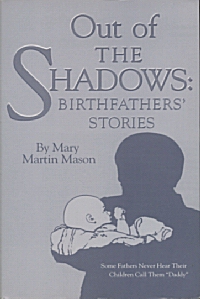
Out of the Shadows:
Birthfathers’ Stories
by Mary Martin Mason
O.J. Howard Publishing, Edina, MN, 1995
This book consists of interviews, over a period of time, with seventeen men. Some of them were fathers of children relinquished for adoption; some were noncustodial fathers where the birth mother was raising the child(ren); some were dealing with the imminent birth of a child, to whose mother they were not married. Some were living at a shelter in Minnesota, down and out; some were successful professionals. Some were involved in on-going relationships with their children, while some had not seen their children in many years. The author let the men tell their own stories, for the most part, which allows the reader to see them as whole and complex persons, rather than the author giving us short quotes and snatches of comments as part of a research narrative from her own point of view. She does not draw conclusions or make generalized statements about birth fathers.
By conducting several interviews with each man, over a period of months, she was able to get more in-depth and honest stories, and she was able to see changes in their attitudes and circumstances, and in some cases, changes in their relationships with their offspring. One man was still trying to find his children and hoped that publication of the book might help, if his grown son and daughter saw the book somewhere. In some cases, the birth fathers had married the birth mothers, subsequent to the first child being relinquished, and have had the pain of that void in their lives.
Reading this book would be helpful to many adult adoptees, and adoptive parents in particular, to help them see this wide variety of birth fathers. It may also be of help to birth mothers to read of various birth fathers’ stories, some similar to the father of their child, some very different. It can be healing, after years of being told to forget the birth father’s existence, or to think of him as a heartless shadow in their past, to acknowledge that, he was a real human being, probably with mixed feelings, who may have thought about his child often.
This book is essential reading for therapists who deal with long-term adoption issues, as well as those working in the field of relinquishment and placement. There are few up-to-date, non-judgmental resources available on the subject of birth fathers, and this book gives long-term perspectives as well as the thoughts and feelings of birth fathers at the time immediately surrounding the child’s birth.
The author herself is an adoptee and an adoptive parent, as is the photographer. As we’ve noted with other books, this personal knowledge of the adoption triad seems to lead to books that are readable, believable, and more balanced in viewpoint than some written by supposedly “unbiased” authors and researchers.
O.I. Member
Excerpted from the July 1998 edition of the Operation Identity Newsletter
© 1998 Operation Identity